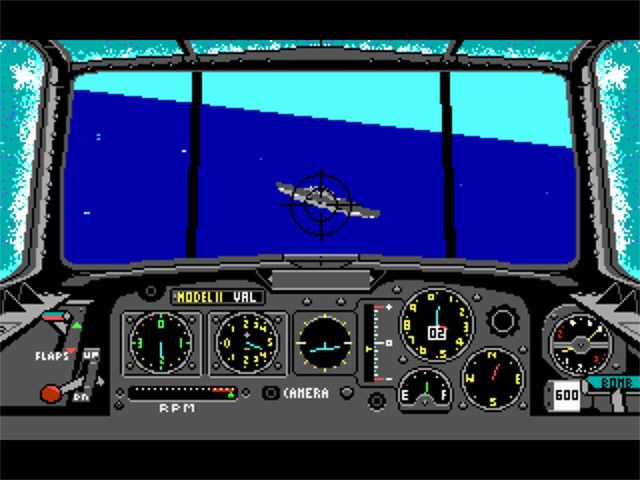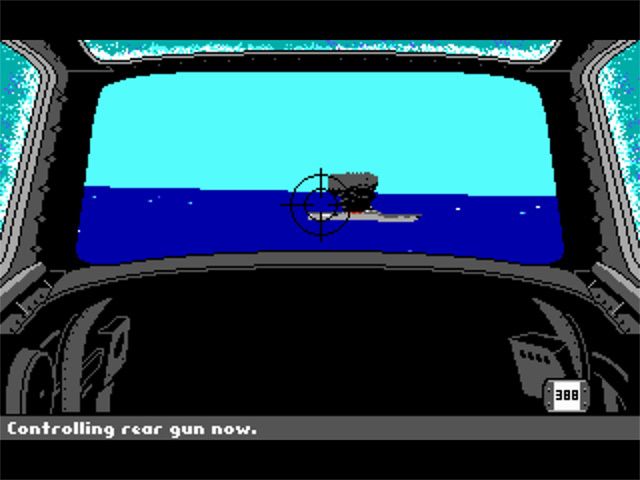=================================================
"Prisoner of Ice" -- DOSBox 0.72 for Linux
=================================================
This post is intended specifically for users of DOSBox 0.72 for Linux, who want to run the game, "Prisoner of Ice"; either the full, commercially-distributed CD (which I have, $4.69 total cost on eBay) or the CD-rip version, available on many abandonware sites. The game runs best if all game files are copied to hard disk, then using the created directory and its subdirectories as an emulated CD drive. That is how I chose to do it, and the game's performance and playability is actually better than when I first ran it on my AST 486DX2-66 MHz machine. Some of these tips listed here should be readily adaptable to other operating systems.
1. The directory </home/myuserID/msdos/> is mounted as my C drive in DOSBox by typing:
mount c /home/myuserID/msdos/
2. The "Prisoner of Ice" game-files directory is found at:
/home/myuserID/msdos/prisoner/
and under the <prisoner> directory are three subdirectories, named as they are found on the game CD. They are:
/home/myuserID/msdos/prisoner/savesvga/
/home/myuserID/msdos/prisoner/savevga/
/home/myuserID/msdos/prisoner/video/
Copy game files on the CD to the corresponding directory and subdirectories on hard disk. The file <__ICE__.PAR>should read as follows:
LANGUAGE_LETTER=A
OPTIONS_PATH=c:\imotion\ice
Edit the file, if it does not. For my installation, no changes were needed.
3. To mount the D drive, as an emulated CD drive, in DOSBox I type:
mount d /home/myuserID/msdos/prisoner/ -t cdrom
So, once DOSBox has started, I type:
mount c /home/myuserID/msdos/ <Enter>
mount d /home/myuserID/msdos/prisoner/ -t cdrom <Enter>
This process of mounting drives can be automated, eliminating most of the typing, but since I play one game completely through before beginning another, I do not bother with special configuration files or autoexec lines.
4. The game can be played in either of two display modes, by selecting <D:\ICE320.EXE> or <D:\ICE640.EXE>. I use <D:\ICE640.EXE> to start the game. The first time the game is started, a directory <C:\IMOTION\ICE> will be created, where game configuration files and saved games will be stored. Configure the sound card for sound effects and music before beginning a new game. My sound configuration is set for SB16. Once the game is configured, two files will be seen: <ICE.CFG> and <ICE.PCK>.
5. My </home/myuserID/.dosboxrc> file is copied below. My </home/myuserID/DOSBOX.CONF> file reads the same. I cannot guarantee that my settings will give equally good performance on other machines, but I would advise keeping cycles=6000, or possibly slightly lower, for "Prisoner of Ice", to avoid compressing the timed sequences too much, which could make the game unbeatable. On my machine, cycles=3000 is too low, and is not recommended. Note that I do not use aspect correction or scaling for this game, which would slow performance.
=================================================
START .DOSBOXRC AND DOSBOX.CONF
=================================================
# This is the configuration file for DOSBox 0.72 running "Prisoner of Ice".
# Lines starting with a # are comment lines.
# They are used to (briefly) document the effect of each option.
[sdl]
# fullscreen -- Start dosbox directly in fullscreen.
# fulldouble -- Use double buffering in fullscreen.
# fullresolution -- What resolution to use for fullscreen: original or fixed size (e.g. 1024x768).
# windowresolution -- Scale the window to this size IF the output device supports hardware scaling.
# output -- What to use for output: surface,overlay,opengl,openglnb.
# autolock -- Mouse will automatically lock, if you click on the screen.
# sensitivity -- Mouse sensitivity.
# waitonerror -- Wait before closing the console if dosbox has an error.
# priority -- Priority levels for dosbox: lowest,lower,normal,higher,highest,pause (when not focused).
# Second entry behind the comma is for when dosbox is not focused/minimized.
# mapperfile -- File used to load/save the key/event mappings from.
# usescancodes -- Avoid usage of symkeys, might not work on all operating systems.
fullscreen=false
fulldouble=false
fullresolution=original
windowresolution=original
output=surface
autolock=true
sensitivity=100
waitonerror=true
priority=higher,normal
mapperfile=/home/myuserID/MAPPER
usescancodes=true
[dosbox]
# language -- Select another language file.
# memsize -- Amount of memory DOSBox has in megabytes.
# machine -- The type of machine tries to emulate: hercules,cga,tandy,pcjr,vga.
# captures -- Directory where things like wave,midi,screenshot get captured.
language=
machine=vga
captures=/home/myuserID/msdos/temp/
memsize=64
[render]
# frameskip -- How many frames DOSBox skips before drawing one.
# aspect -- Do aspect correction, if your output method doesn't support scaling this can slow things down!.
# scaler -- Scaler used to enlarge/enhance low resolution modes.
# Supported are none,normal2x,normal3x,advmame2x,advmame3x,hq2x,hq3x,
# 2xsai,super2xsai,supereagle,advinterp2x,advinterp3x,
# tv2x,tv3x,rgb2x,rgb3x,scan2x,scan3x.
# If forced is appended (like scaler=hq2x forced), the scaler will be used
# even if the result might not be desired.
frameskip=0
aspect=false
scaler=none
[cpu]
# core -- CPU Core used in emulation: normal,simple,dynamic,auto.
# auto switches from normal to dynamic if appropriate.
# cycles -- Amount of instructions DOSBox tries to emulate each millisecond.
# Setting this value too high results in sound dropouts and lags.
# You can also let DOSBox guess the correct value by setting it to max.
# The default setting (auto) switches to max if appropriate.
# cycleup -- Amount of cycles to increase/decrease with keycombo.
# cycledown Setting it lower than 100 will be a percentage.
core=dynamic
cycles=6000
cycleup=500
cycledown=20
[mixer]
# nosound -- Enable silent mode, sound is still emulated though.
# rate -- Mixer sample rate, setting any devices higher than this will
# probably lower their sound quality.
# blocksize -- Mixer block size, larger blocks might help sound stuttering
# but sound will also be more lagged.
# prebuffer -- How many milliseconds of data to keep on top of the blocksize.
nosound=false
rate=22050
blocksize=2048
prebuffer=30
[midi]
# mpu401 -- Type of MPU-401 to emulate: none, uart or intelligent.
# device -- Device that will receive the MIDI data from MPU-401.
# This can be default,alsa,oss,win32,coreaudio,none.
# config -- Special configuration options for the device. In Windows put
# the id of the device you want to use. See README for details.
mpu401=intelligent
device=oss
config=
[sblaster]
# sbtype -- Type of sblaster to emulate:none,sb1,sb2,sbpro1,sbpro2,sb16.
# sbbase,irq,dma,hdma -- The IO/IRQ/DMA/High DMA address of the soundblaster.
# mixer -- Allow the soundblaster mixer to modify the DOSBox mixer.
# oplmode -- Type of OPL emulation: auto,cms,opl2,dualopl2,opl3.
# On auto the mode is determined by sblaster type.
# All OPL modes are 'Adlib', except for CMS.
# oplrate -- Sample rate of OPL music emulation.
sbtype=sb16
sbbase=220
irq=7
dma=1
hdma=5
mixer=true
oplmode=auto
oplrate=22050
[gus]
# gus -- Enable the Gravis Ultrasound emulation.
# gusbase,irq1,irq2,dma1,dma2 -- The IO/IRQ/DMA addresses of the
# Gravis Ultrasound. (Same IRQ's and DMA's are OK.)
# gusrate -- Sample rate of Ultrasound emulation.
# ultradir -- Path to Ultrasound directory. In this directory
# there should be a MIDI directory that contains
# the patch files for GUS playback. Patch sets used
# with Timidity should work fine.
gus=false
gusrate=22050
gusbase=220
irq1=7
irq2=7
dma1=1
dma2=5
ultradir=/home/myuserID/msdos/ultrasnd/
[speaker]
# pcspeaker -- Enable PC-Speaker emulation.
# pcrate -- Sample rate of the PC-Speaker sound generation.
# tandy -- Enable Tandy Sound System emulation (off,on,auto).
# For auto Tandysound emulation is present only if machine is set to tandy.
# tandyrate -- Sample rate of the Tandy 3-Voice generation.
# disney -- Enable Disney Sound Source emulation. Covox Voice Master and Speech Thing compatible.
pcspeaker=false
pcrate=22050
tandy=off
tandyrate=22050
disney=false
[joystick]
# joysticktype -- Type of joystick to emulate: auto (default), none,
# 2axis (supports two joysticks,
# 4axis (supports one joystick, first joystick used),
# 4axis_2 (supports one joystick, second joystick used),
# fcs (Thrustmaster), ch (CH Flightstick).
# none disables joystick emulation.
# auto chooses emulation depending on real joystick(s).
# timed -- enable timed intervals for axis. (false is old style behaviour).
# autofire -- continuously fires as long as you keep the button pressed.
# swap34 -- swap the 3rd and the 4th axis. can be useful for certain joysticks.
# buttonwrap -- enable button wrapping at the number of emulated buttons.
joysticktype=none
timed=true
autofire=false
swap34=false
buttonwrap=true
[serial]
# serial1-4 -- set type of device connected to com port.
# Can be disabled, dummy, modem, nullmodem, directserial.
# Additional parameters must be in the same line in the form of
# parameter:value. Parameter for all types is irq.
# for directserial: realport (required), rxdelay (optional).
# for modem: listenport (optional).
# for nullmodem: server, rxdelay, txdelay, telnet, usedtr,
# transparent, port, inhsocket (all optional).
# Example: serial1=modem listenport:5000
serial1=dummy
serial2=dummy
serial3=disabled
serial4=disabled
[dos]
# xms -- Enable XMS support.
# ems -- Enable EMS support.
# umb -- Enable UMB support.
# keyboardlayout -- Language code of the keyboard layout (or none).
xms=true
ems=true
umb=true
keyboardlayout=US
[ipx]
# ipx -- Enable ipx over UDP/IP emulation.
ipx=false
[autoexec]
# Lines in this section will be run at startup.
=================================================
END .DOSBOXRC AND DOSBOX.CONF
=================================================
6. If the game crashes and an error message is displayed just after Captain Lloyd is grabbed by the tentacled monster very early in the game, the drives have not been mounted correctly. The crash is due to the game's autosave feature failing to locate the savegame directory.
=================================================
My system specifications are as follows:
Compaq Deskpro EN, Pentium III 933 MHz, 256 MB RAM, 20 GB HDD, RivaTNT2 AGP Card, 17-inch HP L1720 LCD Monitor, Mandriva Linux 2007.0, DOSBox 0.72
=================================================



